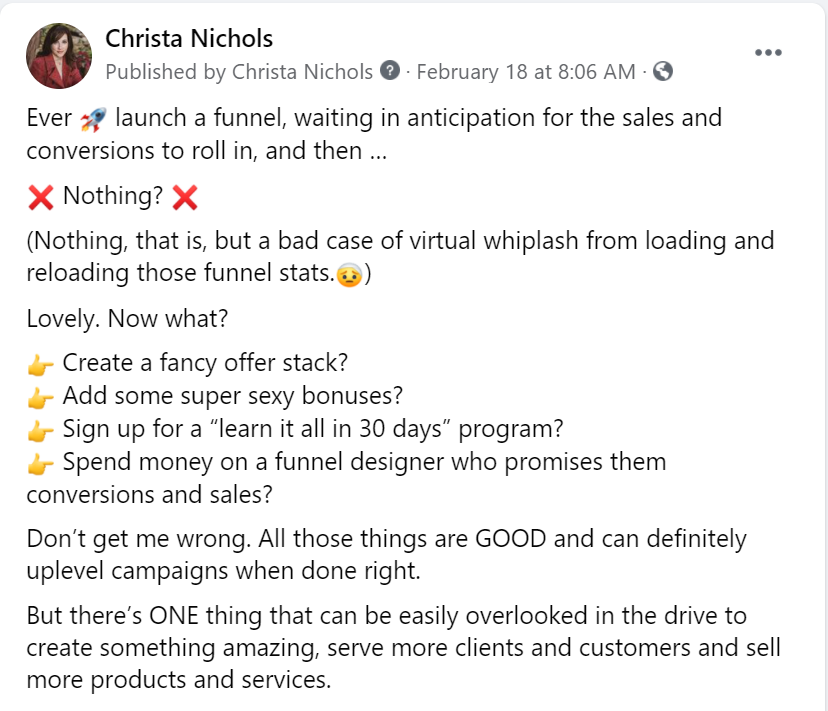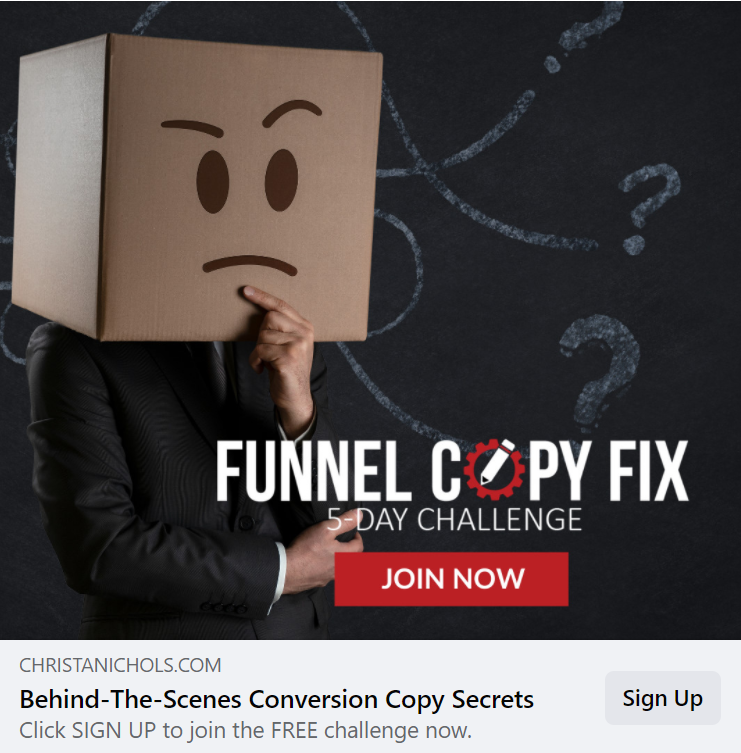
Want to know how to write Facebook ad copy that coverts? Keep reading, because I’m going to give you my four best tips!
With over two billion daily active users, the Facebook platform offers massive advertising potential. For years, Facebook has dangled cheaper click throughs and costs per acquisition than its more commercial (and less personal) competitor, Google.
But that doesn’t mean Facebook ads are easy. A million combinations of elements goes into the success of an ad campaign, including the ad image or video, who the ad targets, how long the campaign runs, and where the ad is shown.
And then, of course, there’s that one thing that causes countless people to gnash their teeth in frustration and want to bang their heads against the wall – the ad copy.
I’ve written thousands upon thousands of sets of Facebook ad copy for a multitude of industries and offers over the years. As a coach and a service provider, I’ve also been asked a lot of questions about Facebook ad copy.
What should I say?
How should I say it?
How much copy do I need?
Is there such a thing as too MUCH ad copy?
It all boils down to the same thing though. No matter how it comes out, the real question my clients and students are asking is really this:
How do I write Facebook ad copy that converts?
In this article, I’m going to give you the four most important things your ad copy must do in order to get the click: stop the scroll, make it matter, communicate clearly about the offer, and give a compelling call to action. I’m also going to tell you three things you should AVOID at all costs. Let’s get started.
Stop the Scroll

The very first (and most important) thing your Facebook ad copy must do is grab attention. And when I say the very first thing, I mean if the first few lines of ad copy don’t get the reader to stop scrolling, nothing else in the ad copy matters.
When people are scrolling Facebook, the feed is in motion. If we’re to believe in the laws of physics, objects in motion will remain in motion unless something causes the stop.
Social media isn’t read like a book. It’s skimmed. If the first few lines of copy don’t grab the reader’s attention, they’ll be gone within three seconds.
The solution? Use strong, attention-grabbing hooks. Facebook allows 125 characters before it cuts the ad copy off with “See More”. Make the most of every single character by focusing on emotional impact. What can you say in 125 characters that will surprise, amuse, sadden, anger, or otherwise engage the reader?
The hook in the ad pictured speaks directly to the target audience – a person with a sales funnel – and then delivers enough of a cliff hanger that they have to click to find out what happens. But this wasn’t the only hook I tested with this offer. I also had ad copy versions that used:
“Optimized sales copy is the key to boosting 🚀 funnel conversions by 1% … 2% … 5% or more!”
“Want to talk about weird superpowers? I have funnel 👀 vision.”
“What’s more frustrating than a sales page that’s not converting? 🤔 Well there’s … and then there’s …”
Always test multiple hooks, that way if one doesn’t work, another might. And one more thing – don’t underestimate the importance of the ad image or video. Choose eye-catching creatives that pair well with the hooks you’re using. This one-two combination has the best chance of stopping the scroll.
Make It Matter
Once your strong hook and eye-catching image or video has stopped the scroll, the ad copy’s next job is to keep people reading. For this, the ad copy must connect with the reader on an emotional or personal level.
In other words, make sure they understand why this should matter to them. If people don’t immediately see how what they’re reading relates to them, they’ll resume the scroll and you’ll never hear from them again.

One solution? Mirror back what they’re thinking, feeling, or experiencing in their own lives. This ad copy dials in on the frustration they feel when their funnel copy doesn’t convert, pokes holes at some of the things they’ve likely tried to fix it, then raises the idea that there’s something they’re overlooking that could solve their problem. And THAT – solving their problem – matters to the reader.
Mirroring is such a powerful strategy in ad copy because it makes the reader feel seen, heard, and understood. If they can relate to what the ad copy says, they’ll start to trust the messaging (and the messenger) without even realizing it. They’ll want to keep reading to find out what they’ve been missing.
Communicate Clearly About The Offer
The reader is now personally invested in the ad, so it’s time to give them what they’re looking for. It’s time to tell them what they’re going to get when they click.
One of the biggest mistakes I see people make with Facebook ad copy is not communicating clearly about what they’re offering. This is such a bummer because it’s 100% preventable. If the reader gets to the end of the ad copy and they’re not sure what’s being advertised, they’re much less likely to click.
Don’t let that happen to you. The solution? Tell them exactly what they’re going to get and the result they can expect if they use it.

Look at the example above. This ad copy is super clear about what’s being offered if they click, right down to a bulleted list of features. But features aren’t all that’s covered. The ad copy also gives them a clear result they can expect – the ability to optimize their sales funnel copy for higher conversions and sales using the same system used on 7- and 8-figure clients’ campaigns.
Do people with sales funnels want to be using the same strategies 7- and 8-figure earners use to optimize their ad copy? You bet they do!
Compelling Call to Action
The final thing that must be included in your ad copy in order for it to convert seems like a minor detail, but it’s not.
They’ve read through the copy. They’re invested in the result promised. But if you don’t tell them EXACTLY what they need to do next, they may get lost on the way. In other words, don’t assume the reader automatically knows what comes next.
The solution? Give a compelling call to action that leaves no room for confusion.

You’ll see the call to action in the Facebook ad copy in a couple different places. The first place you’ll see it is at the very bottom of the ad copy, as in the example where it says, “Click the SIGN UP button now to join.” Simple and clear.
The second place you’ll see the call to action is in the text under the image headline next to the button where it says, “Click SIGN UP to join the FREE challenge now.” Also simple and clear, but it gives a bit more information about what’s being offered (a FREE challenge), just in case they skimmed the copy and missed that part.

Don’t make it complicated. Just tell them what you want them to do, how to do it, and when.
Three Things to Avoid
Just as there are certain things you must do for converting Facebook ad copy, there are also several things you should avoid – and these are just as important. Here are my top three things NOT to do if you want your ad copy to convert.
First, don’t take too long to get to the point. I like to introduce the offer within the first 3-4 paragraphs, if not sooner. You don’t want the reader to have to go clear to the end of the ad copy before they understand what’s being offered. Plus, if you want to display your ads on Instagram, you only get 2200 characters for your ad copy. And really, the goal of the ad is simply to get the click. 2200 is sufficient.
Second, don’t have multiple calls to action in a single ad. Asking the audience to do more than one thing can be confusing, and they’ll rarely end up doing more than one action. That means you’re splitting the audience and getting less response than you might if you just limited the call to action to one thing. It’s tempting to say, “Go listen to the podcast episode, then click the link to download the free guide”, but don’t do it. If they do listen to the podcast, they’ll never make it back to the free guide, and you’ll never capture their email for a lead.
Third, don’t assume the audience knows or understands more than they do. This one is especially important when you’re marketing to cold audiences. It’s very easy for the owner of the offer to be so close to it that they think the reader will “get it” and immediately see the offer and understand why they need it. Don’t make that mistake. If they don’t “get it”, they’re gone.
More from Christa Nichols
Love these ad copy tips? I give more tips just like this inside my free Facebook group, The Confident Copywriter. Click the link to request to join to get access to the free Friday Live Trainings at 10 a.m. CST. https://www.facebook.com/groups/theconfidentcopywriter
